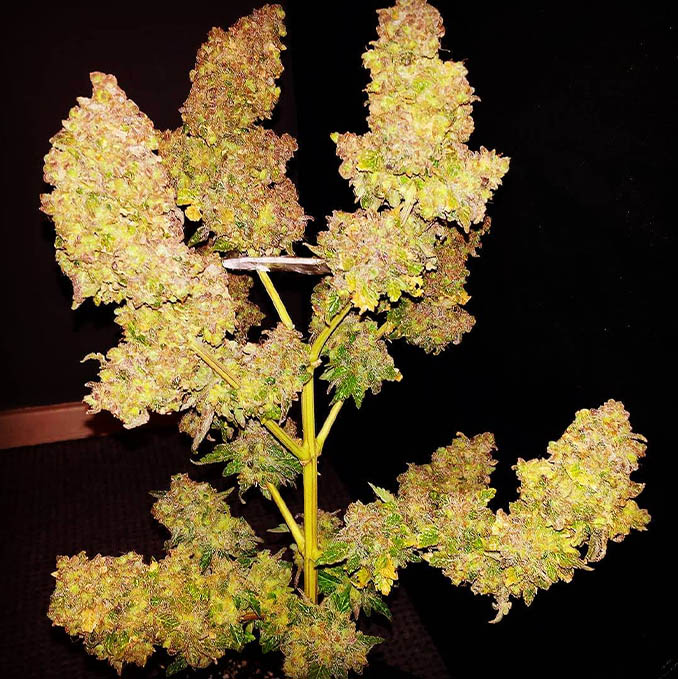What You Need To Know About Cannabis Micro-Growing
Published :
Feb 16, 2018
Categories :
Cannabis cultivation

Micro-growing is the optimal solution for growers with limited space and resources to facilitate a successful cannabis grow. By optimising several necessary variables, you can crop impressive buds in spaces as small as a cabinet.
As cannabis is moving more and more into the mainstream domain, more and more novice cultivators are looking into cropping their own cannabis plants. Few individuals have the large space requirements and breadth of knowledge to set up a full-sized grow. “Micro” means small, and micro-growing involves cultivating few cannabis plants in environments with major spatial and resource limitations. The process of micro-growing is perfect for new growers looking to experiment with home cultivation, without wasting money and time on a crop that may never come to fruition. In short, micro-growing is the predominant way growers find out if the process is right for them.
Because micro-grow operations are usually conducted in very small spaces - think closets and tiny spare rooms - it is very important to cultivate with the goal of keeping things as simple and compact as possible. This, of course, is easier said than done. With this guide, however, we hope to provide general tips on maximising the variables that go into micro-growing.
CHOOSING THE CORRECT LIGHTING
Lighting is a crucial element in any cannabis grow, and there is a lot of debate surrounding which lights are most ideal for each kind of operation. The most potent lighting system is the obvious choice, but it isn’t ideal in all cases. For a micro-grow, excess heat and light too close to the canopy can seriously damage your plants. It just so happens that the most powerful lighting systems also usually produce a lot of heat.
While some of this heat can be mitigated with proper cooling and venting practices, this also has its limitations. As a result, micro-growers are largely limited in what they can use. Here’s a breakdown of the most popular lighting systems.
• HPS: HPS lamps, which are a tried and tested staple in indoor grow environments, tend to produce a lot of heat. For this same reason, we do not recommend using an HPS lamp that is stronger than 250 watts in an area that is 1.5 metres or lower. It will simply generate too much heat, leading to heat stress and an amalgam of other potential issues. If the potency of a 250W bulb doesn’t let your plant flourish, it is possible to combine or supplement with LED or CFLs, which do not generate as much heat.
• CFL: These fluorescent tubes, as we have all seen in offices, generate very little heat. At the same time, they are far less potent than HPS bulbs and can be placed closer to the canopy without overheating the plants. Also, they are fairly affordable. However, CFLs are primarily used during the vegetative stage, as you would need several lamps to accommodate the changing requirements of your flowering plants. A more blue light spectrum is desired during vegetation, while a red light spectrum is more advantageous during bloom.
• LED: LED lighting is becoming better and more popular every year, and is a very suitable solution to our heating problem. It has a wide light spectrum, able to generate all the colours HPS and CFL can, but it generates very little heat in the process. LED lighting does come with an issue, however; it can be quite expensive outright. This might not be the solution if you are looking to build your cannabis growing space on a tight budget.
THE ELEMENTS: EARTH, WIND, AND WATER
Airflow is important to all cannabis cultivators, but especially so for micro-growers. One of the best ways to achieve healthy air circulation in very small grow-ops is to use computer fans. These are small and silent, and easy to set up.
Place an exhaust fan near the top of your grow space, and leave an opening in the lower end. The hot air generated by the lights will rise and be ejected by the exhaust fan. This allows new, fresh, cool, and CO₂-rich air to flow in. For extra cooling, install an intake fan at the bottom of your space to make the process more streamlined. For stealth grows, it’s usually important to install a carbon filter, which neutralises the odours formed during the bloom phase.
Depending on the relative humidity of your micro-grow space, your plants may require more watering than they would regularly. Although you should still take care not to overwater, don’t be surprised if your plant’s need for moisture is elevated. Given that most micro-growers crop indica or indica-dominant hybrids, the plants will likely become bushy and compact. Make sure you are able to easily water your plants by pruning or training as necessary. More on that later.
Your choice of soil is also quite important. It should be rich and drain well. Anything with a muddy or clay texture is a no-go. One consideration, especially for smaller operations, is the actual amount of soil used. Large containers will obviously take up too much space and may make it harder to light your plants. At the same time, tiny containers will stunt growth and make your plants rootbound. When looking to achieve “normal height” plants, you’ll want a 12l container. If you want to contain growth, 5l will limit height to around 60cm while 2-3l will allow the plant to only reach 24cm. It’s all about your exact limitations, strain, etc. Square containers take up less space than round pots. Low and broad containers are often a good fit for most indoor micro-grow environments.

CHOOSING THE RIGHT STRAIN FOR THE JOB
It might not come as a surprise that not every strain is equally suited to be grown in small spaces. Most sativa or sativa-dominant strains simply grow too tall to be used in a micro-grow setting. They often stretch 2-3x their size during bloom, reaching upwards of 3m in some instances.
Autoflowering and indica strains, on the other hand, usually grow to be much smaller and more compact. It’s rare for indicas to stretch over twice their size during bloom, barring major stress conditions. Despite their smaller stature, the bushy nature of indicas allows them to produce just as much, if not more bud than some towering sativas. Autoflowering strains have a distinct advantage; these cultivars do not depend on a change in light cycle to initiate bloom, and their entire cycle from seed to harvest is usually very fast. This is why so many growers are cropping high-quality auto strains when attempting their first couple micro-grows. If after all this advice, you are still hell-bent on growing a sativa, check out the next section.
GROWING TECHNIQUES TO KEEP IT MICRO
Training techniques are used by cultivators to limit the height and/or increase the yield potential of their plants. A method that is used a lot in cannabis grows is topping. Topping involves cutting off the main stem so two new main colas will form instead of one. This allows not only for bushier plants capable of producing denser, higher-quality colas, but also limits the height significantly. Topping can be done as soon as the plant has 4-6 nodes or three pairs of fully formed leaves. Topping can be done during the vegetative stage of growth, but should not be conducted during flowering.
Another technique that can help control height is ScrOG or screen of green. This method involves tying down and weaving new growth beneath a screen that keeps plants at a certain height. This will force the plant to grow more horizontally, giving the buds more light exposure and thus, potentially boosting yield.
Low stress training or LST is a bit similar to what we try to achieve with a ScrOG, but instead of tying the branches to the screen, branches are bent and restrained to grow in a certain position sans screen. This in turn creates more side branches, limiting apical dominance. Higher yields and more compact plants are to be expected.
MORE WHERE THAT CAME FROM
In addition to the above, there are numerous other requirements growers must consider like nutrient feeding and pest/disease control. Hopefully, this article gave you a solid foundation on the logistics and tips surrounding a successful micro cannabis grow. Now, it’s up to you to conduct further research and get growing!






































